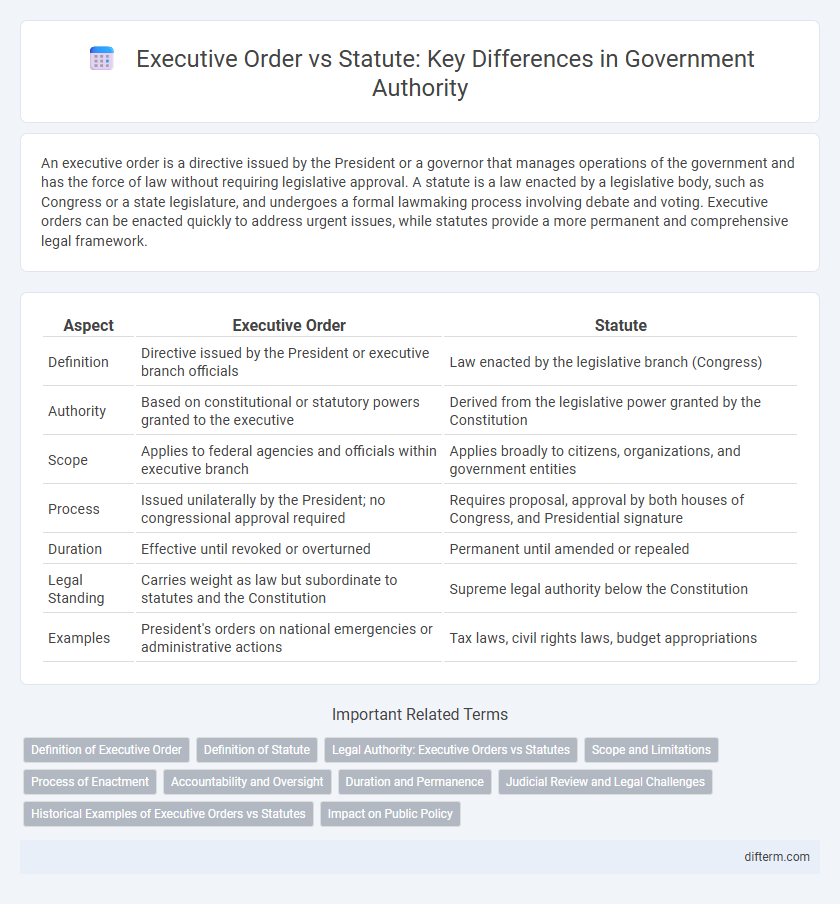An executive order is a directive issued by the President or a governor that manages operations of the government and has the force of law without requiring legislative approval. A statute is a law enacted by a legislative body, such as Congress or a state legislature, and undergoes a formal lawmaking process involving debate and voting. Executive orders can be enacted quickly to address urgent issues, while statutes provide a more permanent and comprehensive legal framework.
Table of Comparison
| Aspect | Executive Order | Statute |
|---|---|---|
| Definition | Directive issued by the President or executive branch officials | Law enacted by the legislative branch (Congress) |
| Authority | Based on constitutional or statutory powers granted to the executive | Derived from the legislative power granted by the Constitution |
| Scope | Applies to federal agencies and officials within executive branch | Applies broadly to citizens, organizations, and government entities |
| Process | Issued unilaterally by the President; no congressional approval required | Requires proposal, approval by both houses of Congress, and Presidential signature |
| Duration | Effective until revoked or overturned | Permanent until amended or repealed |
| Legal Standing | Carries weight as law but subordinate to statutes and the Constitution | Supreme legal authority below the Constitution |
| Examples | President's orders on national emergencies or administrative actions | Tax laws, civil rights laws, budget appropriations |
Definition of Executive Order
An executive order is a directive issued by the president or a governor that manages operations of the government and has the force of law without requiring legislative approval. Unlike statutes passed by Congress, executive orders are based on existing statutory or constitutional authority and can be used to direct federal agencies and officials. Executive orders are critical tools for implementing policy quickly and managing public administration within the executive branch's scope.
Definition of Statute
A statute is a formal written law enacted by a legislative body, such as Congress or a state legislature, which establishes legal standards, mandates, or prohibitions. Unlike executive orders issued by the President or governors, statutes undergo a comprehensive legislative process involving debate, amendment, and approval by elected representatives. Statutes hold the authority of law and serve as the primary source of legal rules governing behavior and government operations.
Legal Authority: Executive Orders vs Statutes
Executive orders derive their legal authority from the president's constitutional powers and specific statutes, allowing for direct management of federal agencies without congressional approval. Statutes, however, originate from legislative acts passed by Congress, carrying broader and more permanent legal authority subject to judicial review. While executive orders can be swiftly enacted and rescinded by the president, statutes establish binding legal frameworks with extensive regulatory impact across government agencies and the public.
Scope and Limitations
Executive orders are directives issued by the President or a governor to manage operations within the executive branch, limited to the authority granted by existing statutes or the Constitution. Statutes are laws enacted by the legislative branch with broader scope, establishing legal obligations and rights that apply universally within a jurisdiction. While executive orders can be swiftly implemented and address administrative matters, they cannot override or contradict statutory law and are subject to judicial review.
Process of Enactment
An executive order is issued directly by the President or a government executive, allowing swift implementation without the need for legislative approval. A statute requires drafting, committee review, debates, and voting through the legislative branch before becoming law. This legislative process ensures broader participation and typically involves multiple stages including public hearings and amendments.
Accountability and Oversight
Executive orders allow the President to manage operations of the federal government with immediate effect but face limited congressional oversight, raising concerns about executive accountability. Statutes, enacted by Congress, undergo a rigorous legislative process and are subject to broader accountability mechanisms through legislative review, judicial interpretation, and public transparency. The statutory framework ensures more comprehensive oversight by multiple branches, promoting checks and balances in governance.
Duration and Permanence
Executive orders are temporary directives issued by the President or executive agencies, often lasting only as long as the issuing administration remains in power unless rescinded or superseded. Statutes, enacted by the legislative branch, establish laws with indefinite duration, remaining in effect until repealed or amended by future legislation. The permanence of statutes provides a stable legal framework, whereas executive orders offer flexible, short-term policy adjustments.
Judicial Review and Legal Challenges
Executive orders, issued by the President, are subject to judicial review to ensure they do not exceed constitutional or statutory authority and are often challenged in courts for potential overreach or conflict with existing laws. Statutes, enacted by Congress, carry legislative authority but can also be challenged through judicial review if alleged to violate constitutional provisions. Courts evaluate both executive orders and statutes based on their adherence to the Constitution, with invalidation occurring if either is found unconstitutional or beyond legal scope.
Historical Examples of Executive Orders vs Statutes
Historical examples highlight the distinction between executive orders and statutes, with President Abraham Lincoln's Emancipation Proclamation issued as an executive order while the Civil Rights Act of 1964 was enacted as a statute by Congress. Executive orders allow presidents to manage federal operations and direct agencies rapidly, whereas statutes require legislative approval, often involving detailed debate and amendments. Landmark executive orders like Franklin D. Roosevelt's Executive Order 9066, which authorized Japanese American internment during World War II, contrast with broad statutory laws such as the Affordable Care Act, demonstrating the scope and limitations of both instruments.
Impact on Public Policy
Executive orders allow the President to swiftly implement public policy changes without requiring legislative approval, enabling rapid response to emerging issues. In contrast, statutes, passed by Congress, provide more durable and comprehensive policy frameworks through a deliberative process, often reflecting broader consensus. The differing durations and scopes of these instruments significantly shape the stability and flexibility of public policy implementation.
executive order vs statute Infographic

 difterm.com
difterm.com